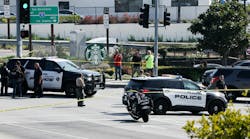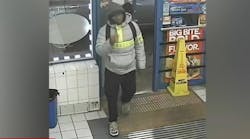*This column is dedicated to Frank. A police officer who has languished in prison for 35 months on a righteous OIS incident.
Frank was a part-time officer for a small agency. Off-duty at the time of the shooting at his rental home, in his jurisdiction, the call came to him. Frank would end up shooting a male suspect who was charging at him after repeated orders to get on the ground. The male, who Frank had recognized from a prior domestic violence incident in which two officers had to threaten him with Tasers in order to gain compliance, had a BAC on this night of .253. He was 85 lbs. heavier and nine and a half inches taller than Frank. As Frank said in his statement that night to investigators, “I don’t know if you’re aware of XXXX or what kind of build he has, but he’s at least two of me. I just didn’t want him to hurt me or kill me.”
A political prosecution had an interim district attorney running for his first election (which he subsequently lost) charging Frank with murder. Facts in evidence indicate that Frank identified himself as a police officer, thus transitioning from “off-duty” to on-duty, entitling him to the same legal authority as any other officer in that state. Though Frank’s agency had a policy which indicated an attorney on-call would be contacted prior to any statement or interview, they failed to all him. Frank thus gave a consensual interview to the state investigators that night. The prosecutor made a motion that policy did not apply because Frank was part-time and not a “bargaining unit member.” The state investigator’s went through the entire state basic academy curriculum underlining and making marks at areas they thought they could use against Frank. The prosecutor’s expert, who had little grasp of the laws of use of force, engaged in a tactical critique on Frank’s actions that night claiming, amongst other things that the use of deadly force was bad because Frank didn’t have his agency I.D. and only armed himself with his handgun not his entire duty belt when trouble presented itself. He even suggested that because Frank knew the suspect, his propensity for violence and his size and weight, that he do nothing.
On Monday morning, with the benefit of 20/20 hindsight from the safety of your office, all things are crystal clear…
Totality of the Circumstances Equals Context
When you use force and when detectives or supervisors investigate force, they need to dig a little deeper than just the surface, i.e. Frank shot an unarmed man, or Officer Jason Van Dyke of the Chicago Police Department, shot a 17-year-old suspect armed with a knife. In the prosecution of Van Dyke, the prosecutor’s expert witness acknowledged under oath that he did not know that Laquan McDonald had attempted to stab a truck driver just moments before.
Question: How many volunteers do I have to get within 15 feet of a suspect to Taser him when he’s armed with a knife, already attempted felonious assault, slashed a police cruiser windshield and stabbed its tire, refused to stop despite numerous commands, and has already run?
How about inside 20 feet?
You know the distance in which a Taser, depending on the cartridge, is deployed from.
Not many takers huh? What about when this same suspect closes the distance towards Van Dyke from 30 feet to an estimated twelve feet?
Well, the prosecutor’s expert stated on the stand, “…the police officer could have waited for that first step.” Consider that that same expert wrote that a knife can be a deadly threat out to 30 feet? Also consider that the same expert has written (well I might add…) that the wound impacts on a suspect will not render him incapable of closing the distance and stabbing an officer. He even has written about the justification of the use of deadly force by an officer in a similar incident.
“Off Into the Weeds”
Instead of answering the basic question – was the officer’s use of force objectively reasonable at the moment they used force based on their reasonable perceptions and the totality of the circumstances, these D.A.’s, prosecutors, investigators, expert witnesses and social justice warriors go astray from the law and the legal aspects of the 4th Amendment seizure question, with all manner of nonsense.
Item: the defense witness in the Van Dyke trial as well as the prosecutor improperly stated the law vis-à-vis Graham v. Connor and Tennessee v. Garner. The attorney who teaches use of force for Chicago P.D.’s academy referred to the standard as “reasonable and necessary.” Note – those words together do not appear in Graham or Garner. Further, the prosecutor stated that in the Garner decision, deadly force is to be used as a last resort. Here’s what SCOTUS wrote in the Graham decision, ““The Court today holds that the Fourth Amendment prohibits a police officer from using deadly force as a last resort…”
There are certainly a plethora of social justice warriors, some even law professors, who are intent on states in our country restricting police use of force to a reasonable and necessary standard to reduce “police violence” as they term it (one wonders why so many academics and legal “experts” deny the real facts of police use of force?)
But the realities of state laws throughout the U.S. on police use of deadly force are that only (1) state, Idaho, uses the standard “reasonable and necessary” while most others use some version of “He is justified in the use of any force which he reasonably believes to be necessary.” This is, substantially different as it is based on what the officer, on scene, believes is necessary, not some attorney.
Video
The problem with video and its many forms – Body Worn Camera, cell phone, and surveillance video, is that we think the images we see tell exactly what happened, when in reality, the images can be false, or at least misleading. There are many aspects of video: GOP – Group of Pictures which include I frames (frames of video which are entirely refreshed), as well as P frames (Predictive) and B frames (Bi-directional) which reconstitute images to compress the file size by looking forward, rearward or both. That’s right sports fans, the image on the video could be completely inaccurate. Frame rate or, the number of images the system captures each second, could lead investigators or the public to believe that the officer’s actions were faster or more violent than they actually were. Time between frames can miss valuable information such as suspect’s movements.
The problem with video and especially BWC video, is that agencies embraced the technology without first studying its issues. In many cases, it takes a trained eye and advanced technology to analyze images caught on video of police use of force.
Wrap-Up
Frank’s incarceration (facing 20 or more years in prison for a crime he did not commit or pleading guilty to a reduced sentence requiring him to only serve one more year after 29 months already served, had him plead out in September of last year). This was, in my opinion, a miscarriage of justice which will affect me (I served as the defense expert in the case) for the rest of my life.
Why when the law is clear do such miscarriages occur?
It is simply the times we police in.
What can you do? As a part-time officer, know your policy, get clear cut answers as to the fact that it applies to you, carry some type of professional insurance, and make sure you don’t make a statement until you have an attorney present. Full-time officers protected by a police union, need to make sure their union attorney is present as well and that their union rep is on-scene protecting their rights.
All officers need to make sure a review of any/all video evidence is part of the reporting process. The standard is usually an original statement unaided by video, then a video review, as part of the interview process.
All officers must spend more time and more effort in articulating what they’ve done. You did the right thing, now is the time to accurately and effectively say why.
Law enforcement has changed and we are now in the phase when prosecution of officers for political reasons has become the norm. To ignore that is to expose yourself to the politics of force and the war on cops.



